Orden del día de la sesión de 6 de febrero de 2015
9:00 horas en primera convocatoria y media hora más tarde en segunda, en la Sala de Juntas del edificio Convalecencia, que se desarrollará conforme al siguiente
ORDEN DEL DÍA
1. Aprobación, si procede, del acta de la sesión anterior, celebrada el día 19 de diciembre de 2014.
2. Informe del Sr. Rector
3. Informe y ratificación, en su caso, de acuerdos adoptados en la Comisión Permanente de 14 de enero de 2015.
4. Informe y aprobación, si procede, de Convenios:
4.1. Tramitados a través de Secretaría General.
4.2. Tramitados a través del Vicerrectorado de Transferencia, Emprendimiento y Empleo.
5. Autorización, si procede, de concesión de premios extraordinarios adicionales de las Facultades de Biología y de Informática.
6. Aprobación, si procede, de modificación del Reglamento de régimen interno de las Facultades de Trabajo Social, Enfermería, y Comunicación y Documentación.
7. Aprobación, si procede, de modificación del Reglamento de régimen interno del Departamento de Métodos de 8. Investigación y Diagnóstico en Educación.
8. Aprobación, si procede, de reconocimiento de créditos por actividades universitarias (CRAU) del artículo 10 del Reglamento vigente.
9. Informe de modificaciones presupuestarias del tercer trimestre de 2014.
10. Aprobación, si procede, de propuesta de modificación de precios públicos para Unidad de Gasto 004D Mantenimiento-Área de Unidad Técnica.
11. Aprobación, si procede, de asuntos varios del Vicerrectorado de Formación e Innovación:
11.1. Cursos de posgrado, cursos, congresos, jornadas y seminarios que se acogen al catálogo de precios públicos.
11.2. Cursos de posgrado, cursos, congresos, jornadas y seminarios que no se acogen a catálogo de precios públicos y propuesta de precios públicos.
11.3. Informe del cuarto trimestre de Estudios Propios de aprobación directa por la Comisión de Formación e Innovación.
12. Aprobación, si procede, del Plan de Formación Corporativa 2015.
13. Aprobación, si procede, del II Plan Director de Formación Corporativa 2015-2018.
14.Aprobación, si procede, de asuntos varios del Vicerrectorado de Profesorado: 14.1. Solicitudes de plazas de profesorado para el curso 2014/2015. 14.2. Solicitud de permiso sabático. 14.3. Solicitudes de permisos de personal docente.
15. Aprobación, si procede, de asuntos varios del Vicerrectorado de Planificación de Enseñanzas:
15.1. Propuestas de nuevos másteres universitarios.
15.2. Propuesta de adscripción de asignaturas a áreas de conocimiento.
15.3. Modificación de la tabla de adaptación de Licenciado en Ciencias Ambientales.
15.4. Másteres universitarios que inician proceso de extinción.
15.5. Modificación de los Programas de Doctorado en Ciencias de la Salud y Ciencias de la Empresa.
Aprobación, si procede, de modificación de la Norma de implantación de Programas de Estudios Simultáneos.
Ruegos y preguntas.


